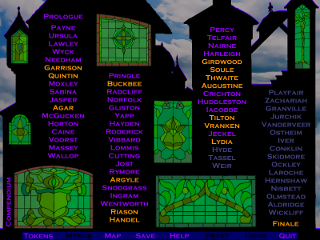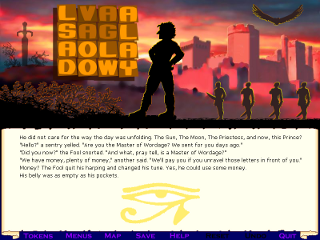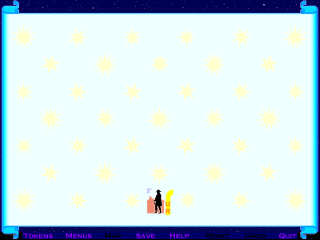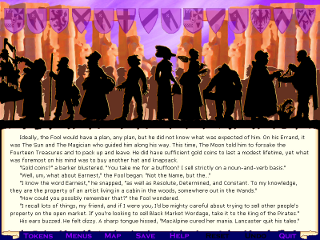The Fool and His Money -- talking about the game now
Monday, October 29, 2012
Comments: 20 (latest December 9)
Tagged: reviews, ruminations, the fool and his money, cliff johnson, word puzzles, metapuzzles

Okay, I did my moral homily, now I'll talk about the game. It occurs to me that some of my readership may not have played The Fool's Errand.
Well... probably most of my readership here has, because my friends include a lot of Mystery Hunt types. Plus people who (like me) were already gamers when TFE came out in (oy) 1987. Plus people who played System's Twilight, my TFE homage from (gah) 1994.
So, for the rest of you! The Fool and his Money is a puzzle collection wrapped in a narrative, with more puzzles hidden in the gooey center.
It's not an adventure game. The early example of TFE played hell with my notion of what an adventure game was, because it had puzzles and text and a story just like Zork, but it... was... something else. Years of research and meditation (--playing more games) clarified the distinction: The Fool games do not present you with an explorable game world. You don't find a puzzle by looking under a rug; you find a puzzle on your screen. This is not a flaw, this is a different outlook.
(Potential sidetrack for student discussion: the narrative in TFE and TFahM is third-person, rather than the traditional second-person text of IF. Does this make a difference to the genre? Why? Contrariwise, they have an explorable interface, within their simple mouse-and-click bounds. Is that like the interface conventions of text or graphical IF?)
The Fool games do have a clear genre analogue -- though I wasn't familiar with it when I played TFE back in college. They're puzzle extravaganzas, like the Mystery Hunt I mentioned earlier. So:
- a collection of puzzles, presented en masse or in groups;
- with few or no instructions, so that the solving process involves experimentation;
- of varying types, often variations on familiar themes but usually with creative twists which must be figured out;
- in two or more layers, where the puzzle solutions become clues for further "metapuzzles", so that the final challenge can only be attacked when all (or most) of the earlier puzzles are complete.
All clear? So much for the generalizations. What's TFahM like?

The Fool is returning from his earlier Errand, with the fourteen Treasures in his bindlestiff, when wham! Pirates. They even steal his pointy hat. Beyond that, there's something terribly wrong with the kingdom... And then the puzzles begin.
The puzzles include word/letter puzzles and general symbolic/pattern puzzles. (A couple so far with light arithmetic, but no math puzzles per se.) Rather heavier on the word puzzles. These are very broad categories I'm using, of course. On the one hand you wind up putting letters in grid, pulling letters out of grids, anagramming, assembling word fragments into sentences, dividing words into groups... and on the other hand there are jigsaw puzzles, arranging symbols to line up without duplicates, tracing geometric paths, and so on.
These puzzles mostly abjure dexterity and mouse-clicking skill. The very first (jigsaw) puzzle throws in a click-things-fast twist, which really isn't typical of the game as a whole. (I'm not sure why the author thought it was a good idea.) Don't be disheartened; it is possible to avoid that part of the puzzle if you plan carefully. A later puzzle requires some careful clicking with a time constraint, but it's not too bad (though perhaps worse if you're using a trackpad rather than a mouse). I'm halfway through the game so there are probably more like that I haven't seen. It's not a huge thing; just be aware that it's not a pure-brainpower game.
I'd say that the Johnson has greatly improved the way he sequences his puzzles. TFE was a wild grab-bag of puzzle forms. This game still has a variety, but they're more harmonious. Rather than totally off-the-wall gags (everyone remember the Three Ships?), we get variations on the puzzle forms, which increase smoothly in complexity as you progress through the game.
Are these familiar types? That depends on your context. Some of the puzzle forms are imported directly from the original TFE. Others start that way but then, as I said, get changed up and altered. Yet other types are (as far as I can recall) entirely new to Johnson's work.
If you're not familiar with his earlier games, you're going to be in new territory. These are not Zork-style puzzles, nor Myst-style puzzles, nor the types rehashed endlessly in the modern hidden-object genre.
You start with about a dozen puzzles unlocked. Each time you solve one, another one opens up, so you always have a range of stuff to work on. Of course, as you play, the list of open puzzles will accumulate more and more of the ones you're stuck on... that's life, I'm afraid. You're going to have to finish everything eventually, so don't totally neglect the evil ones. Come back to them occasionally and see if you can't make a little bit of progress.

And then you reach the meta stages. I haven't, yet, mostly. I've found a couple of puzzles which are unlocked by earlier puzzles, and one set of challenges hidden in a way which one must experiment to discover.
The primary metapuzzle mechanism is the Moon's Map, which starts out blank, and accumulates pieces as you solve puzzles. Once it's complete -- well, if it works like the Sun's Map in the original TFE, you'll have to unscramble it like a jigsaw, and then solve a new set of revealed puzzles.

The clues will come from everything you've solved thus far. Puzzle answers, letters and symbols that appear on completed puzzle screens, and -- I don't know what else! There are definitely some suspicious phrases in the story text, though. As with any good puzzle extravaganza, the story gives thematic cues and allusive comments that support the developing meta.
A few strategic tips for the newcomer to this field. Not hints -- rather, expectations. I don't want anybody to try this game on a whim and be thrown into a shark pit.
-
This is not a casual puzzle game. This is a brain-burner. I am blasting through it pretty fast, but I have, you know, a flexible schedule. "Halfway through" represents a bunch of my gaming hours since Thursday.
-
Don't be shy about pressing the "Help" button. It doesn't give spoilers or hints. It only tells you the general shape of the puzzle. Yes, it's fun to try to work that out yourself, and you should certainly experiment too. But as soon as you stop making progress, go ahead and read the help text. Probably that's where the solving will start. (It often gives some handy shortcut keystrokes, too.)
-
Expect frustration. I meant it about "not casual"! Even with the puzzle variations, you will come to dread Yet Another Round of those damn whatever-it-is-you-dread.
-
And yet, you will solve them.
-
The twelve tarot cards on the title screen are your save slots. You would have known that if you'd pressed the "Help" button.
-
You will need scrap paper. Or a text file to take notes in. But eventually, probably scrap paper to draw on, too.
-
For hacker-type people: writing a program to solve a puzzle is solving the puzzle. It's totally not cheating at all. I have a directory called "fooltricks" where I am accumulating Python scripts which have helped me solve various puzzles. (I still have the C program I wrote in 1989 to solve the 3x3 letter grids in TFE! I've been saving it in this directory for years.)
-
Using an anagram tool or searchable word list is maybe cheating a little bit. But I do it. It makes many of the puzzles easier, but it doesn't make most of them easy; you still have to think and experiment. (I like the Internet Anagram Servant. If you're on a Mac or Linux, you've got a word list in
/usr/share/dict/words.)
-
If you're not an experienced puzzle person, work with someone. (This is a valid tip for all kinds of puzzle and adventure games.)
-
Don't get the idea that every puzzle in TFahM is insanely difficult. Some of them are quite easy! It's just that, you know, you wind up spending all your time on the hard ones.
-
Losing sleep on this game is a very real hazard.
-
I am throwing progress tweets on #foolandhismoney.
I have come to the end of this review, and I realize I have not been jumping up and down yelling "Play this game!" Please understand, I am jumping. You should play this game -- if you like puzzles, if you like challenges, if you like working all-out on crazy-hard puzzles where they barely even tell you the rules. The Fool's Errand was a great game; The Fool and His Money is a better game. So far. I am going to finish it (forwarrrrrrd!) and I do not expect it to disappoint me.
There's a demo, by the way -- in case I haven't convinced you yet. (See "Teaser" on the game site.) It came out a couple of years ago, but it represents the first five puzzles of the game accurately, as best I can recall.
I am told that when you buy the game online, your license key email may take a few hours to show up. Possibly more. Watch spam folders, as usual, etc. Also, er, Cliff Johnson is being walloped by a hurricane this week, which may impact his ability to fulfill orders.
Comments imported from Gameshelf
Ori Avtalion
(October 30, 2012 at 10:24 AM):
On the other hand I feel like the puzzles were designed to be solvable by a brain and a pen and a piece of paper.
I agree, although I see no reason not to use a mechanical letter-swapper to aid solving the anagrams in the "Literal" puzzles where you have to type letters in order. That interface is just silly (a proper anagram interface appears in the "Curses" puzzles).
I also used a screenshot to solve the stained window "Tracer" puzzles.
Andrew Plotkin
(October 30, 2012 at 12:29 PM):
Several years of doing large-scale puzzle hunts have taught me that people really are good at different things. A puzzle invitation says "You do not need the Internet to solve this hunt!" and then it turns out that you're expected to be able to remember who played James Bond in each Bond movie. (Not an example from TFahM!) So I smile and nod and pull out IMDB.
I am not very good at anagrams. I mean, I'm okay, but I've co-solved with people who go through anagrams like a knife through utter both. So "designed for paper and pencil" doesn't mean the same thing for them as it does for me, and I reach for the anagram tool.
I have written scripts for several puzzles now, and for what it's worth, none of them have popped out a ready-to-go answer. They've given me parts which I had to wrangle together. I can see that some puzzles are amenable to total-solve scripts (e.g. the buttons-change-shapes ones or the tiny jigsaws) but I've managed to get through those without help.
(The closest to a pure-solve tool I've used is the anagram tool on the crossword-style letter scrambles. And those still require a little bit of extra work, because of the ones where the letters you're unscrambling aren't the complete word.)
A Mandible
(October 31, 2012 at 1:43 PM):
I feel like using an anagrammer for the Junctions would have meant missing out on some of the fun, for me, because of the satisfaction of pebff-fbyivat jvgu gur jbeq-yvfgf jevggra ba jnyyf [rot-13 for spoiler].
I find myself playing the game for hours at a time and then focusing on the negatives, which is surely not a healthy approach to life. I think the thing is, I'm used to flawed single-creator games being sort of charming in their flawedness, while the problems with TFaHM do not, for better or worse, feel tightly bound to the game itself. They're UI issues, or similar-- as Ori mentioned, the Literals are just a bad interface to the same puzzle-type as the Curses. It's frustrating!
On the other hand, I love the new tarot games.
Jon Mann
(October 31, 2012 at 8:00 PM):
It's an interesting progression from solving it on-screen, to taking notes, to using a helper tool, to using a solving tool (plus writing either of the last two). For my part, using an anagram helper feels like cheating - or treading a fine line at the least. And using a program means you miss out on the rush of solving these puzzles without help (the windows in particular). But it does seem to be a game where these boundaries are self-imposed, rather than enforced by design.
Anyway, loving it so far. Looking forward to the next phase of the game...
Kevin Jackson-Mead
(November 2, 2012 at 10:45 AM):
I hadn't played The Fool's Errand before, but thanks to this post, I decided to try it out. I started it the other day, and I'm really enjoying it. Nice mix of easy and challenging, so I feel like I'm actually making progress but don't feel like I can just fly through. I'm anxious to try both System's Twilight and The Fool and his Money when I'm done.
Andrew Plotkin
(November 2, 2012 at 11:57 AM):
Oh yay! Yes, it's worth going through all of these. Do not neglect "3 in Three", which is my favorite of Johnson's original games.
Jason Dyer
(November 3, 2012 at 12:54 PM):
Fool and His Money vs. 3 in Three: which is better?
(3 in Three is my current favorite puzzle game, narrowly beating out DROD and Lemmings 2.)
The teaser puzzles stumped me, so I am replaying Fool's Errand right now (which feels distinctly easier; I never finished the first time through anyway -- got stuck on Three Ships). I managed to get all the map pieces this time and I'm working on assembling them.
Andrew Plotkin
(November 3, 2012 at 1:07 PM):
I can't come up with a meaningful comparison, given that I played 3in3 decades ago, haven't replayed it in years, and then haven't finished FahHM yet.
FahHM is getting both more interesting and more frustrating. I am now down to the last few "front-page" puzzles, meaning the ones that I have no traction on at all, so my solving time has shifted from "steady progress" to "flailing with occasional improvement". On the other hand, I've gotten through several stages of the Other Stuff, which is all clever surprises and new puzzle types.
David Goldfarb
(November 6, 2012 at 4:56 PM):
You said you were halfway through the game -- were you? (I'm betting not!)
I've finally finished. I did make use of the anagram server for some of the scrambled words, because there just comes a time when beating your head against them stops being fun. And one of the other puzzles actually made me go so far as to look online to find out the right syntax for regular expressions in Mac OS X! But I'd say that I solved the majority of them on my own. The hint guide available on Johnson's site has some nice nudges before the outright spoilers; I'm very glad it was available.
Andrew Plotkin
(November 6, 2012 at 5:19 PM):
"You said you were halfway through the game -- were you?"
By puzzle count, sure. :)
I have four puzzles remaining on the main screen. I just looked at my first hint last night (in a chat room, not on CJ's web site) -- it was for the gold coins.
David Goldfarb
(November 7, 2012 at 4:07 AM):
If you have any puzzles remaining on the main screen, then you are not yet halfway through the game. You were halfway through the first half -- although, that first half is less than half because it doesn't include the windows.
Andrew Plotkin
(November 7, 2012 at 2:47 PM):
Well, don't rub it in so much that it becomes a spoiler. :/
I have made significant progress on the windows as well. And I finally have a handle on the A auctions, so I should finish the Kingdoms today. Then we'll see.
David Goldfarb
(November 9, 2012 at 1:41 AM):
I was trying to avoid spoilers -- I hope and and believe that the above is at least not a major spoiler. Anyway, apologies.
Greg Collins
(November 11, 2012 at 5:41 AM):
Mr. P, as usual, a terrific and insightful review -- without even finishing! I did just finish and am going through puzzle withdrawal. Played it for a month. Now what? There isn't even any game wrapper to suck on.
Cheating? It's your game. Do whatever you feel most comfortable with. As for writing programs to help me? God, if only! I did this time abandon pencil and paper about a third of the way through for keeping a word processor open on one monitor while playing the game on the other monitor. Worked pretty well. Ended up with about 40 pages of notes.
I like anagrams. I do the daily Jumble daily. Some of these were, uh, mind-bending. I resorted to little scraps of paper pushed around on a tabletop. That worked not bad too. I was tempted once to use an anagram website. But the string I was trying to unscramble was too long for the program!
Also went through the "I'm halfway through" thing. Then found out I was closer to a third of the way through. Both the 7th House (my favorite part) and the Moon's Map are really whole games in themselves. The map . . .
(imaginary spoiler tag) . . . has two sets of puzzles for pretty much each square. Although it did explain why when I thought I was almost through the game I still had several pages of unused hints. (close imaginary spoiler tag)
By the way, if this page does have actual spoiler tags, I apologize.
It's a great game. Really. The type that no one else could make, and no one interested in a buck ever would. The crazy thing is that -- Cliff Johnson says he doesn't himself play puzzles.
Al Golden
(November 12, 2012 at 10:11 PM):
The hint booklet by Dr. Ken leaves much to be desired. IMHO it should have screen shots for some of the slider puzzles since getting them right was a real chore. Cliff helped out however.
Andrew Plotkin
(November 14, 2012 at 4:05 PM):
All done now. I looked at just two small hints through the whole process (from the social-net-world, not from CJ's web site).
A satisfying three weeks of work. I could start nitpicking and pointing at some puzzles that didn't work as well as other puzzles, but it wouldn't add anything to the review, really.
Nate
(November 22, 2012 at 6:49 AM):
- Expect frustration. I meant it about "not casual"! Even with the puzzle variations, you will come to dread Yet Another Round of those damn whatever-it-is-you-dread.
Yes, this was always the good and the bad with Cliff Johnson's games. You don't like a certain type of puzzle so you ignore it and solve some other type that is far more fun, only to be faced with a whole slew of only the evil puzzles left to work out at the end. But by then of course the bug has bit you and you just have to gnaw your way through them, slowly and painfully, but making steady (albeit tiny) progress. Until of course you finally hit a wall, throw your arms up in frustration and vow never again to play this dastardly game. Until a few days, weeks or years later, depending on how strong your personality is, when you come slinking back for another go at it.
For me it's the 4 by 4 puzzles. They're heinous. I hated the 3 by 3 puzzles from the Fool's Errand and these are worse, much worse. First I skipped them completely, but finally decided I'd have to take them on someday. Worked tirelessly on the first one. I believe it must have been about four in the morning when I finally solved it, leapt from my chair with a whoop and a fist pump, and then sank dejectedly back down again. For I had only solved the first guard's 4 by 4. On that same page, grinning at me with malice were more guards, each with his own 4 by 4 puzzle, each one more hideous than the next.
I hate Cliff Johnson and the worst part is he's proud of that.
Andrew Plotkin
(November 22, 2012 at 12:17 PM):
After you solve a couple of those, you may notice a pattern which makes the rest slightly easier. Just slightly, mind you...
iPadCary
(December 9, 2012 at 1:47 PM):
Jesus Christ ....
It F-I-N-A-L-L-Y came out?!?
I wrote to Cliff a couple of years ago asking if there'd be an iOS version.
The answer was a resounding "NO!" lol


I solved the first jigsaw puzzle without clicking anything fast, because I didn't realize I could. (I thought the HELP button was a HINT button when it is really a RULES button.) I thought it was totally fair. In a way it's less fair with the fast-clicking mechanic, since it leads you to believe that the way to solve the puzzle is with dexterity. Thinking that it had to be solved one slow click at a time led to a nice aha moment.
I am still conflicted on whether to click on HELP, since I enjoyed the first couple of puzzles before I realized that it just gave you the rules. Apparently Johnson thinks it is totally fine to click HELP right away, so I have been. But it makes the puzzles a little less fun than if it didn't exist.
I am also conflicted on whether it is okay to write programs to solve puzzles. On the one hand it is actual brainy work to figure out what code to write and how to use it. On the other hand I feel like the puzzles were designed to be solvable by a brain and a pen and a piece of paper, rather than a brain and a 2Ghz CPU. So far I have resisted to the urge to write any code, but I'm sure I will have to give in before I finish.